Hawaiian Imu
From elgourmand 15 years agoIngredients
- Stuff you’ll need: shopping list
- • 1 Pit about 3’ long by 2.5’ wide by 1.5 ‘ deep; adjust for size of pig. shopping list
- • Enough softball size lava stones to make at least 2 layers in the bottom of the pit, a few more is good. You can use fire bricks but stack them crooked so they heat well. shopping list
- • A fair mound of good hardwood; enough to burn for about two hours. You can use BBQ briquettes but you’ll need a bunch. The stones need to be almost white hot. shopping list
- • Last Sunday’s newspaper. shopping list
- • A can of BBQ starting fluid; kerosene works fine. shopping list
- • 1 large or 2 small banana trees; cut into strips, see pic. If you can’t get these you can use wet sisal bags. The banana stumps are full of water and make steam. shopping list
- • LOTS (as in a whole bunch) of banana and ti leaves; see pics. If these don’t grow where you are you can usually get them an Asian markets. You can also use wet corn husks. shopping list
- • A long handled shovel. shopping list
- • 1 good bush knife (machete). shopping list
- • Two old bed sheets or a poly tarp. We don’t want any plastic in ours so we use the sheets. shopping list
- • A good size piece of chicken wire. This needs to be at least 4’W by6’ L. See pics. shopping list
- • Several crates of good beer and a couple casks of wine. This is optional but just barely. Last Sunday we made up a big batch of sangria, see Sangria De Sydney shopping list
- Ingredients: shopping list
- • 1 whole pig. Less than 20lbs is a waste of time. shopping list
- • Small chickens or cornish Game Hens, prepped; wrapped in banana or ti leaves or foil. shopping list
- • Small fish, tilapia, trout, etc., prepped ; wrapped in banana or ti leaves or foil. You can use chunks of a big fish if you must. shopping list
- • Octopus or squid, cleaned and cut into chunks; wrapped in banana or ti leaves or foil. shopping list
- • lobster or crabs, whole; wrapped in banana or ti leaves or foil. shopping list
- • A few good sausages, kielbasa, Portuguese, etc. ; wrapped in banana or ti leaves or foil. shopping list
- • Breadfruit, skinned; wrapped in banana or ti leaves or foil. shopping list
- • Taro, scraped; wrapped in banana or ti leaves or foil. shopping list
- • Green banana, peeled; wrapped in banana or ti leaves or foil with a bit of coconut cream added. shopping list
- • Taro leaves, cleaned, tips and stems removed; wrapped in banana or ti leaves or foil; 6 or so leaves per packet with some coconut cream added. This is luau. shopping list
- • potatoes and/or sweet potatoes; wrapped in banana or ti leaves or foil. shopping list
- • Artichokes; wrapped in banana or ti leaves or foil. shopping list
- • Corn on the cob; wrapped in banana or ti leaves or foil. shopping list
- • Reckon you get the idea. Anything that can be steamed will do. A little madness here. shopping list
How to make it
- The imu, phase 1:
- 1. Dig the pit. We make ours square sided and that works best.
- 2. Assemble all the” stuff you’ll need”.
- 3. Ball up the pages of last Sunday’s newspaper and toss them into the pit.
- 4. Put about 2/3 of your wood on the news paper and then stack your stones on the wood See Photo. You can add the rest of the wood as needed to keep the fire going for at least two hours.
- 5. Pour the BBQ starter fluid over the lot and light the thing up. We normally do this about midnight. Don’t get in a hurry about the fire. The rocks do need to be REALLY HOT or the thing won’t work
- 6. Go have a beer and get the food ready to go into the imu.
- The food:
- 1. The pig is easy. The villagers did most of the work for us and your butcher will do that for you See Photo. Cut a slit from the anus up to the rib cage and from the top of the rib cage up to the chin. Rub the beasty inside and out with coarse salt and line the cavities with ti or banana leaves. Keep moist.
- 2. All the other stuff you decide to put in the imu should be portioned out into serving size packets and wrapped in fresh, green banana or ti leaves See Photo . These are usually secured with bamboo skewers. If you can’t get enough banana or ti leaves wet corn husks will work and as a last resort you can use foil. The breadfruit, taro and potatoes, etc. Do not need to be wrapped but they come out better if they are. You can add a bit, or a lot, of peepee (coconut cream) to any of the veggies but the taro leaves and green banana really need it.
- The imu Phase 2:
- 1. Okay, the fire has burned down and the stones are hotter than the gates of Hades & everything that is going in the imu is close at hand. See Photo
- 2. Take a few stones out of the pit to go into the cavities of the pig and even out the rest.
- 3. Place a few layers of banana and/or ti leaves on the stones. Make sure these go all the way to the edge of the pit.
- 4. Place two layers of banana stump strips on the leaves See Photo. Make sure these go all the way to the edge of the pit. If you just can’t get these you can use wet burlap sacks, or like that.
- 5. Put the chicken wire over the pit and press down to fit. This makes getting all the stuff out of the pit, once it’s cooked, easier.
- 6. Add a layer or two of banana and/or ti leaves.
- 7. Put the hot stones in the leaf lined cavities of the pig. Use the shovel.
- 8. Lower the pig into the pit belly side up; you can turn it over when you take it out, if that’s important to you. You do need to move right along here as the stones are cooling.
- 9. Add all the other goodies you’ve decided to cook around the pig.
- 10. Add another layer, or three, of banana and or ti leaves See Photo. Make sure these go all the way to the edge of the pit.
- 11. Fold the edges of the chicken wire over the whole shebang.
- 12. Cover this with the old bed sheets. You can use a poly tarp but we don’t want any plastic in our imu so we use old sheets.
- 13. Cover this with the dirt you dug out of the pit to begin with. Make sure your dirt layer is as thick as possible to hold in the heat See Photo. You can cover this lot with burlap sacks, a tarp or cardboard boxes to help hold in the heat, optional.
- 14. If you’re like us, it’s about 3:00 AM and time for the last beer and a bit of sleep. Don’t forget to put more beer on ice for the imu opening.
- 15. It’s about noon and the smell coming from the imu has your gastric juices flowing nicely. Things will be cooked in about 6 hours, depending on how much you put in and how hot the stones are but we usually leave it longer and if you do it right the food never burns. You could start early in the AM and be eating in the afternoon, if you’re in a hurry.
- 16. Get as much dirt off the imu as you can. Things have cooled down a bit so you can use your hands for the last little bit.
- 17. Off with the sheets and the leaves.
- 18. You can take the packets of food out of the imu one at a time if you like and then use the chicken wire to hoist out the pig. You will need a suitable platter or plank to hold the pig.
- 19. Remove the stones from the cavities.
- 20. You can take the pork off the bone if you like but we let people help themselves. The meat is so tender that it just falls off the bone.
- 21. Unwrap the rest of the goodies and dig in.
- Obviously, with a 70lb pig and all the other stuff that went into the imu we had more food left over than we ate. All of this keeps well in the fridge or freezer and you eat Hawaiian again next week. Is this better/different than pork roasted in an oven? Yep. As for condiments and such, I leave that up to you.
The Groups
-
Back To Basics
348 members -

Expats
35 members -

Family Favourites
134 members -

Anything Goes
294 members -

FROM SCRATCH
149 members -

We Love It But
135 members -

Our Daily Dinner
907 members -

Friends In The Kitchen
319 members -

International Dishes
44 members -

World Wide Cuisine
50 members
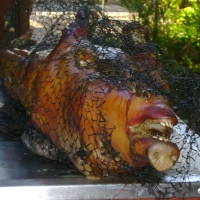
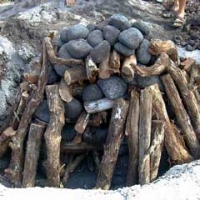
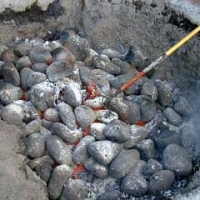
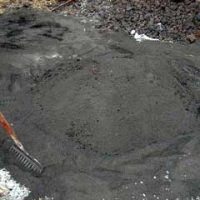
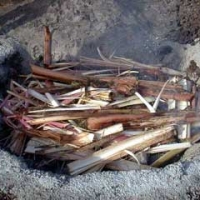
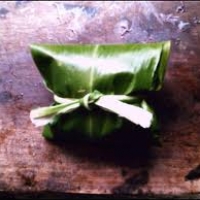
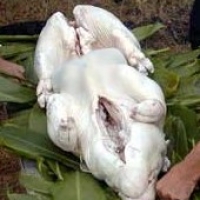
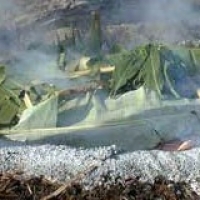


Reviews & Comments 11
-
All Comments
-
Your Comments